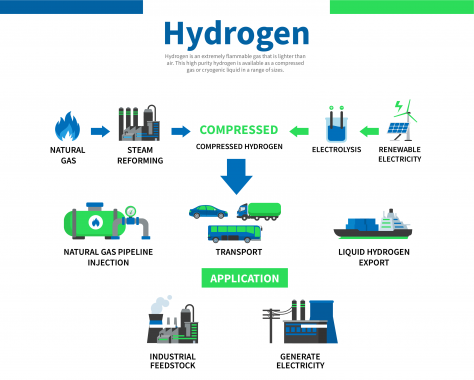Coregas, the only Australian industrial gases company, has the expertise and technology to unlock the massive potential of hydrogen to make the world a greener place. Coregas is involved in many local initiatives driving forward the pursuit of hydrogen as a energy source. It is proud to operated Australia’s largest merchant hydrogen plant in Port Kembla, NSW.

Hydrogen can support efforts to limit global warming. It has the ability to decarbonise large sectors of the global economy. The most promising use cases include hydrogen as a low or zero carbon source of fuel for cars and heavy transport, as feedstock gas for chemical chains and refining, and as fuel for steel production and similar industries.
Frequently Asked Questions
-
What is hydrogen?
Hydrogen is a colourless, odourless, non-toxic gas that bonds easily with other elements. It is not found naturally in its pure form so it needs to be separated from these other elements to be usable in applications such as transport, energy storage, heating, electricity generation and industrial processes. Hydrogen is the most abundant chemical substance in the universe, making up almost 75% of all matter.
-
What are the uses of hydrogen?
There are now many potential uses of clean hydrogen that we have grouped into 5 categories.
1. Input into industrial processes – steel, ammonia, crude refining;
2. Heating and cooking – by blending with pipeline natural gas;
3. Transport – passenger vehicles, commercial trucks and equipment, buses, mining trucks, ferries, forklifts etc;
4. Electricity generation and Storage – electricity production for the grid via gas turbines or fuel cells, and storing excess intermittent renewable generation from wind or solar for later use;
5. Export industry – for most of the uses above.
-
How can hydrogen be produced?
Hydrogen does not exist naturally in its pure form, so it needs to be produced from other substances. There are three main processes for hydrogen production:
1. Coal (or lignite) gasification – thermochemical;
2. Steam methane reformation (SMR) – also thermochemical; or
3. Hydrogen electrolysis – electrochemical.
-
What is the difference between blue and green hydrogen?
Green hydrogen is carbon free: it is produced from renewable energy and non-fossil fuel sources. Blue hydrogen is clean but not green: it is produced from renewable energy and natural gas but the carbon is not released into the atmosphere; it is captured and stored.
-
Why is hydrogen in such high demand?
Hydrogen is a very clean fuel. It only releases water into the atmosphere when combusted. It is therefore viewed as a zero-emission substitute for sectors of the economy that are difficult to abate. Key focus areas and benefits are:
Decarbonisation – Energy results in nearly 3/4 of global CO2 emissions9. Hydrogen is a ‘clean’ form of energy, which is the key reason for all the interest. When used in a fuel cell to produce electricity, the only by-products are water and oxygen. Hydrogen is a key option if we want to hit emission reduction targets.
Versatile with multiple applications – H2 can be produced, transported and used in many different ways. The Hydrogen Council identified 35 separate applications for hydrogen, of which 22 are expected to reach cost parity with other low-carbon alternatives by 2030.
Support for renewables – H2 could be very useful in supporting the continued penetration of variable renewable energy (VRE) (wind and solar). As Alan Finkel put it “… in the dream future where all our energy comes from solar and wind as the primary energy source, around 15-20% of that energy will have to be delivered as a high-density transportable fuel and hydrogen is the ideal candidate.”
Energy Security – Particularly for countries like Japan and South Korea that are big importers of energy, and replacement of other energy source for reasons such as Fukashima incident and phase out of nuclear, and reduction in fossil fuels. These countries have committed to H2 related targets. Domestically, the volatility
Export industry – according to a release by the Victorian Government12, the global hydrogen industry could be worth as much as $2.5 trillion by 2050. If there is going to be strong demand internationally then major energy exporting countries need to start thinking about how to position themselves. Japan has already said it’s going to be a large importer of hydrogen. There are currently no large-scale exporters.
Hydrogen is very energy dense – with an energy content of 120 MJ/kg, equivalent to 33 kWh/kg. To put this in perspective, a 33kWh lithium-ion battery pack, such as those used in electric vehicles like the Nissan LEAF, weighs about 150 to 200 kg – up to 200x more weight for the same energy. The world needs a new, energy-dense, zero-emission, molecular fuel as an alternative to hydrocarbon fuels.
Let us support your hydrogen projects
Contact our professional team for questions about products, pricing, creating an account & more.